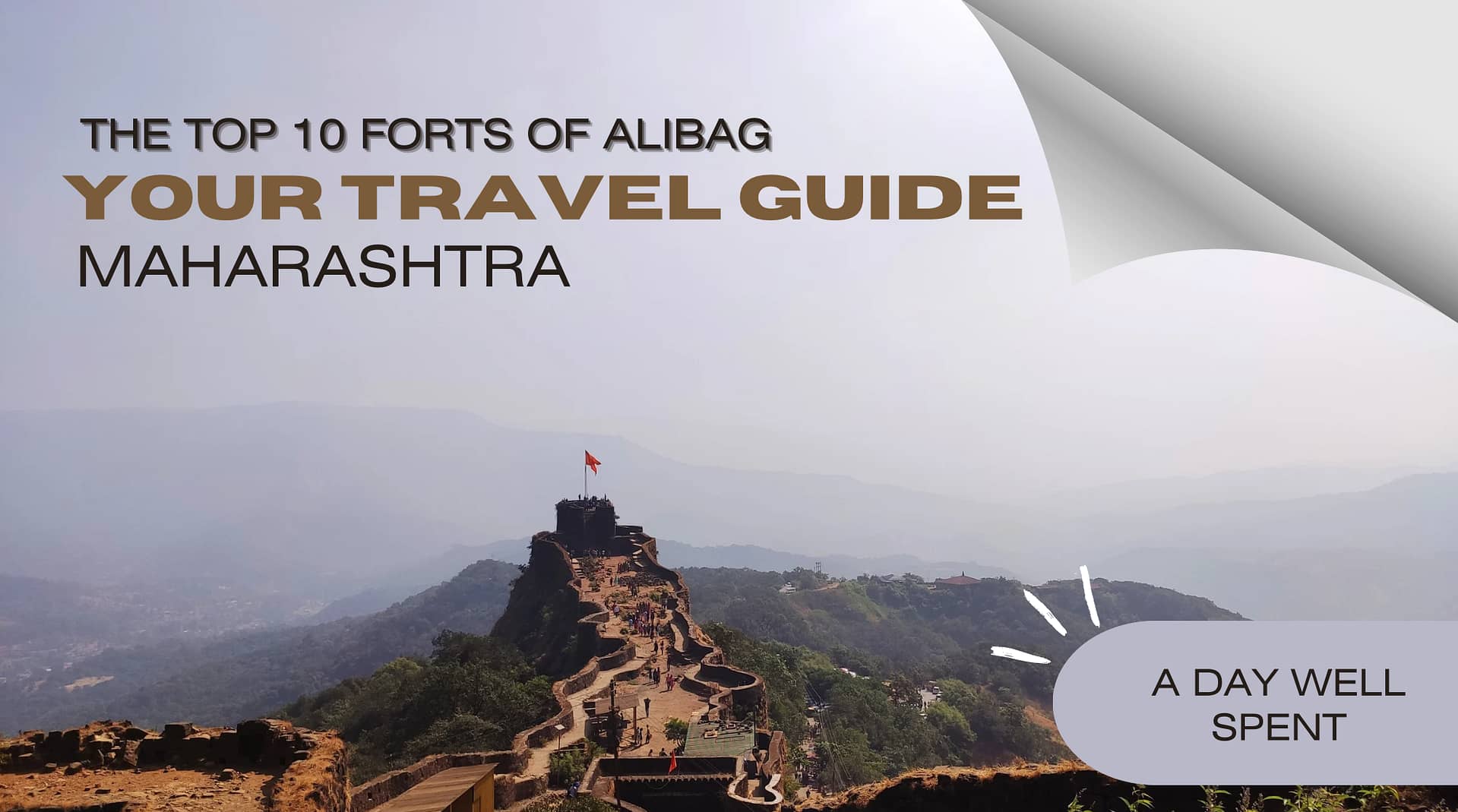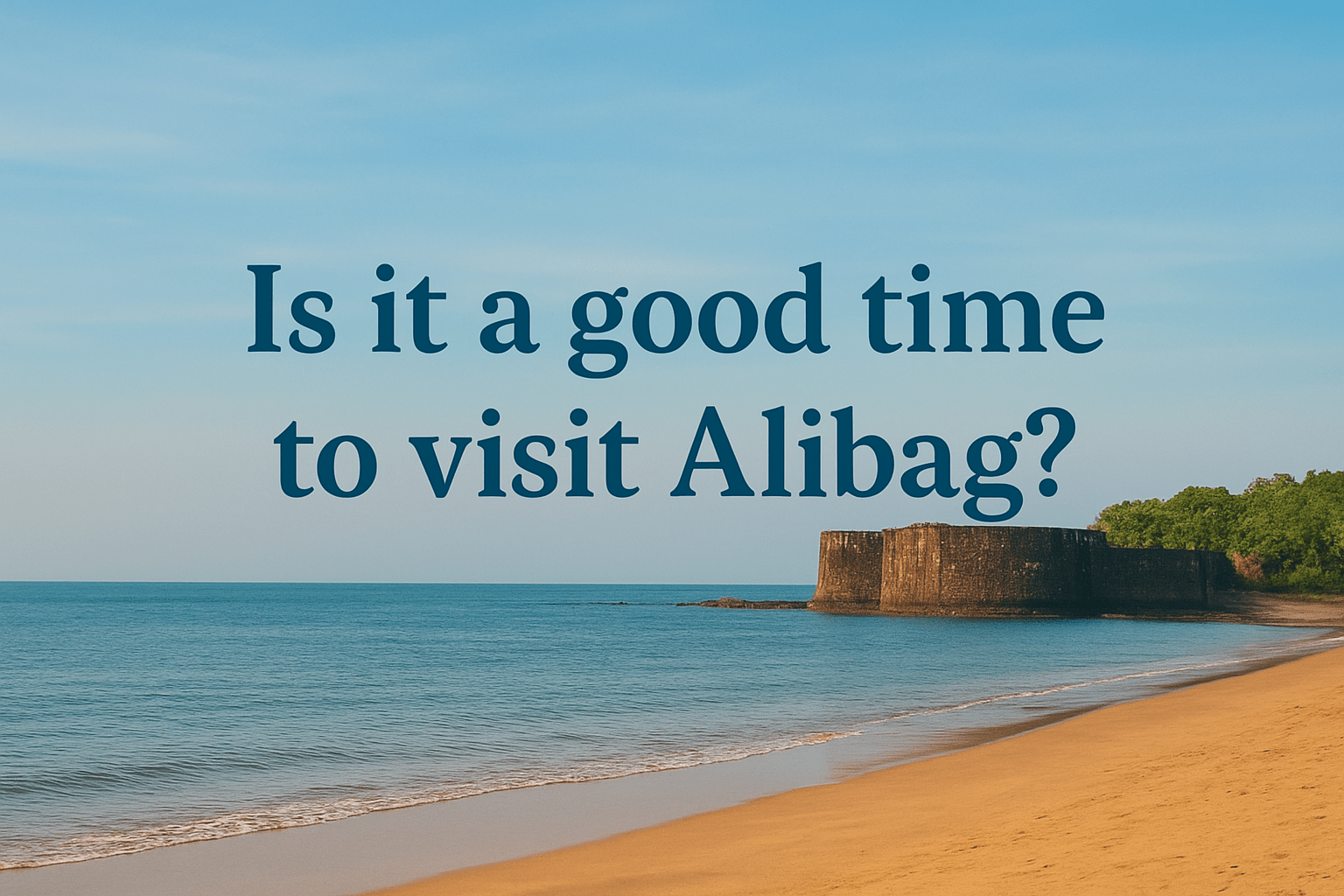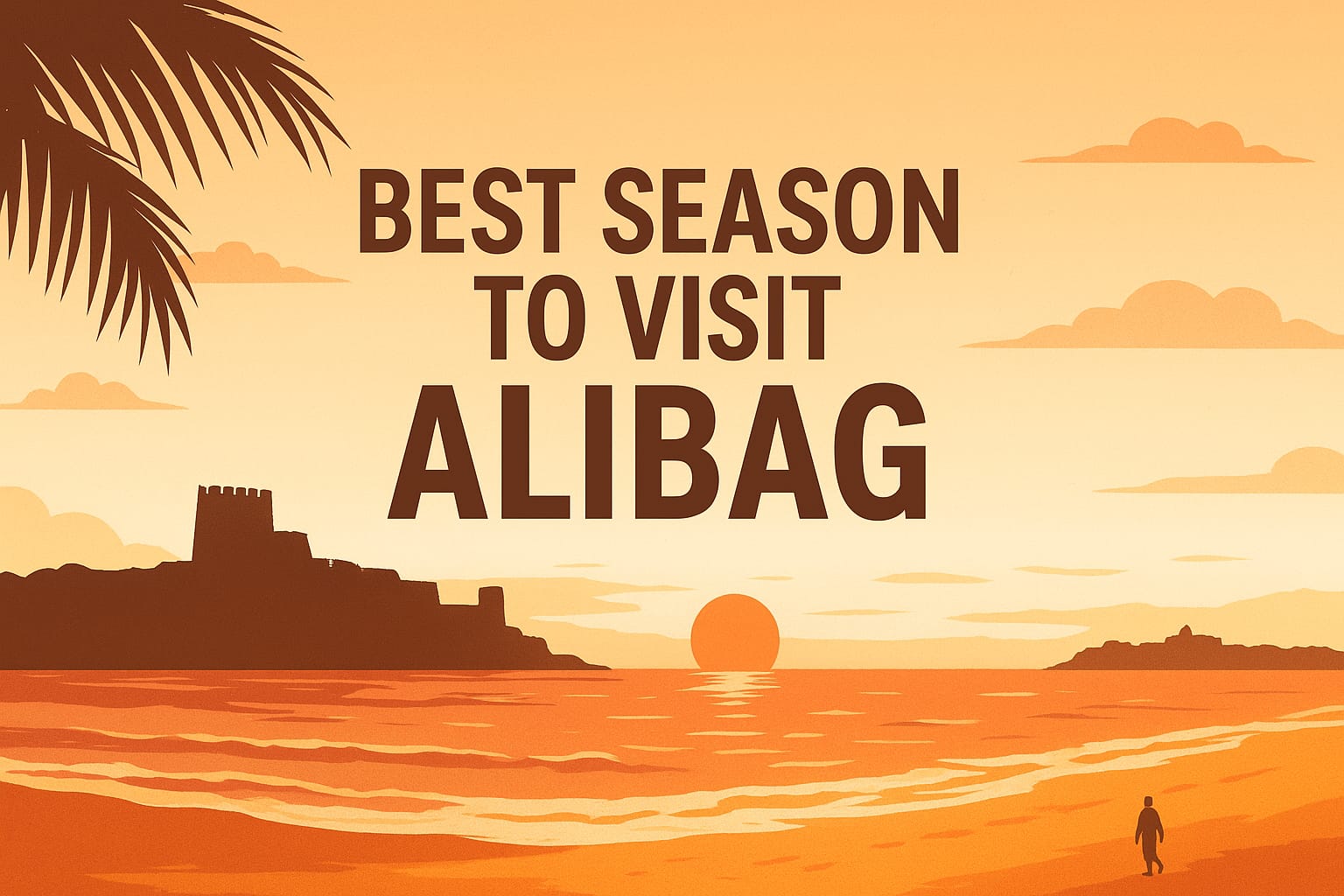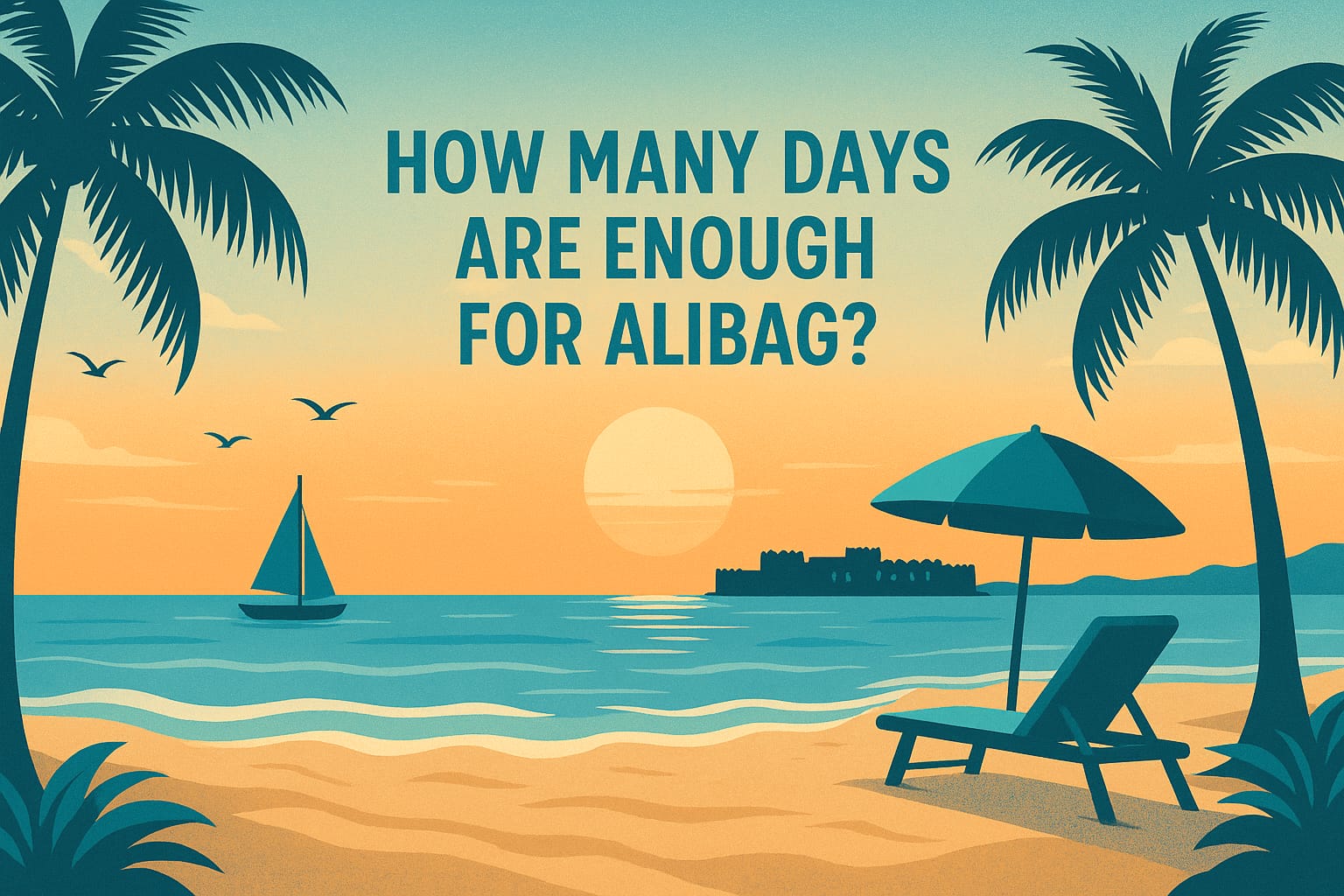The Alibag Fort List represents more than just old buildings by the sea. They are powerful reminders of a time when Alibag stood as a stronghold of Maratha naval power and drew the attention of the Portuguese and British. These forts have witnessed battles, trade, and royal events across centuries.
Kolaba Fort lets you walk through the sea during low tide, while Murud Janjira still stands strong in the middle of the water. Sagargad gives you peaceful valley views after a quiet trek. These are all part of The Untold Forts of Alibag that carry stories in every stone.
Even the quieter places like Undheri, Revdanda, Thal, and Awas have their own charm. Exploring the Forts of Alibag is like stepping into the past, where each corner has a tale to tell and every view brings you closer to the soul of the place.
Top 10 Famous forts in Alibag
1. Kolaba Fort: The Maritime Crown of Shivaji’s Legacy
Kolaba Fort, built by Chhatrapati Shivaji Maharaj in 1680, stands boldly in the Arabian Sea, connected to Alibag at low tide. Its weathered walls, ancient cannons, and quiet temples echo tales of Maratha naval power and forgotten seafarers. Walking through its mossy gates feels like stepping into living history.
| Category | Details |
| Location | 1–2 km from Alibag Beach, Maharashtra |
| Difficulty | Easy (walkable at low tide) |
| Mode of Transport | On foot during low tide / boat ride during high tide |
| Ideal Time to Visit | October to March |
| Travel Time | 20 minutes from Alibag town |
| Entry Fee | ₹5–₹10 (nominal) |
| Time Required | 1.5–2 hours |
| Nearby Attractions | Alibag Beach, Varsoli Beach |
Travel Tips:
- Visit during low tide to walk to the fort without needing a boat.
- Wear sandals that grip well—rocks are slippery.
- Carry water and a sun hat as there’s minimal shade.
- Photography enthusiasts should aim for golden hour.
2. Murud-Janjira Fort: The Sea’s Invincible Sentinel
Murud-Janjira rises from Rajapuri Creek as an unconquered sea fort, known for its 40-foot walls and hidden entrance. Built by the Siddis, it withstood attacks from the Marathas, Portuguese, and British. Among the forts of Alibag, a visit to Murud-Janjira feels like sailing into a legend of strength and resilience.
| Category | Details |
| Location | Rajapuri Creek, Murud, 55 km south of Alibag |
| Difficulty | Moderate (requires boat ride + steps inside) |
| Mode of Transport | Private cab/bus to Murud + boat from Rajapuri Jetty |
| Ideal Time to Visit | November to February |
| Travel Time | 2–3 hours from Alibag |
| Entry Fee | ₹25 for ferry ride |
| Time Required | 2–3 hours |
| Nearby Attractions | Murud Beach, Ahmedganj Palace |
Travel Tips:
- The first boat starts around 8:30 AM, last returns before sunset.
- Guides are available—worth hiring to understand the fort’s complexity.
- Avoid during the monsoon as ferry services are suspended.
- Wear sneakers or hiking shoes—the stairs are steep.
3. Sagargad Fort: The Watchtower of the Sahyadris
Perched high in the Sahyadris, Sagargad Fort offers breathtaking views and a serene trek through forest and history. Once held by Shivaji, it blends natural beauty with ancient charm, featuring waterfalls, a peaceful ashram, and the sacred Pandav Kund.
| Category | Details |
| Location | Near Khandale village, ~13 km from Alibag |
| Difficulty | Moderate to Challenging (trek) |
| Mode of Transport | Cab to base village + 2-hour trek |
| Ideal Time to Visit | Post-monsoon (October–February) |
| Travel Time | 45 minutes to base + 2-hour trek |
| Entry Fee | None |
| Time Required | 4–5 hours (including trek) |
| Nearby Attractions | Dhodhane Waterfall, Siddheshwar Ashram |
Travel Tips:
- Start early to avoid trekking in the midday sun.
- Carry plenty of water and light snacks.
- Leech-proof socks are recommended post-monsoon.
- Ideal for adventure travelers, not recommended for the elderly.
4. Korlai Fort: The Trilingual Tapestry
Korlai Fort, built by the Portuguese in 1521, stands where the Kundalika River meets the Arabian Sea. With trilingual inscriptions and moss-covered walls, it’s a blend of cultures, solitude, and sweeping coastal views—ideal for quiet explorers and sunset lovers.
| Category | Details |
| Location | Korlai Village, ~24 km from Alibag |
| Difficulty | Easy to Moderate |
| Mode of Transport | Cab or bike from Alibag town |
| Ideal Time to Visit | November to March |
| Travel Time | 45–60 minutes |
| Entry Fee | None |
| Time Required | 1.5–2 hours |
| Nearby Attractions | Korlai Lighthouse, Revdanda Beach |
Travel Tips:
- Visit during golden hour for the best photography.
- Carry water, the climb is exposed to the sun.
- Locals speak Konkani, Marathi, and Portuguese Creole.
- Combine with a visit to Revdanda for a full day plan.
5. Talgad Fort – Overlooked but Scenic Trek
Talgad Fort, near Roha, is a quiet hilltop retreat offering scenic views, mossy ruins, and a peaceful Shiva temple. Once part of the Maratha defense network, it’s a short, serene trek ideal for nature lovers and history seekers craving solitude.
Talgad Fort – Travel & Experience Breakdown
| Category | Details |
| Difficulty | Easy to moderate – short trek |
| Mode of Transport | Drive to Roha (35 km) + trek |
| Duration | 2–3 hours |
| Expenses | ₹300–₹500 (transport), no entry fee |
| Facilities | None – carry your own water/gear |
| Best Time | November to February |
Tips for Visiting Talgad Fort
- Ideal for weekend day-treks with less foot traffic.
- Perfect for nature lovers, birdwatchers, and solitude seekers.
- Avoid during monsoon—mud trails can get slippery and overgrown.
- Ask local villagers for trail directions if unclear.
6. Revdanda Fort – Where Silence Meets Sea Spray
Revdanda Fort, set where the Kundalika River meets the sea, is a quiet Portuguese-era ruin wrapped in vines and sea breeze. With crumbling arches and rustling palms, it offers solitude, scenic beauty, and a deep sense of coastal nostalgia.
Revdanda Fort – Travel & Experience Breakdown
| Category | Details |
| Location | Revdanda village, ~17 km from Alibag |
| Difficulty Level | Easy – no trekking required |
| Mode of Transport | Drive or auto from Alibag to Revdanda |
| Visit Duration | 1–1.5 hours |
| Expense (Approx.) | Free entry; ₹100–₹300 for local transport |
| Access Type | Direct road access; no special permits needed |
| Best Time to Visit | October to March (especially during sunset) |
| Nearby Attractions | Revdanda Beach, Korlai Fort, Portuguese Church Ruins |
Travel Tips for Revdanda Fort
- Golden Hour Magic: Visit during late afternoon or sunset for ideal lighting—perfect for photographers or those seeking scenic reflection.
- No On-Site Vendors: Carry your own water and snacks, especially if visiting in the afternoon.
- Combine with Beach Time: Revdanda Beach is a short walk away—ideal for a dip or relaxing under the palms post-visit.
- Footwear Tip: The interiors may have fallen stones or vegetation—wear comfortable walking shoes.
- Ideal for Slow Travelers: Take your time to sit in the archways and listen to the sea; it’s a fort best savored, not rushed.
7. Tung Fort (Also Known as Kathingad)
Tung Fort, also known as Kathingad, is a steep, scenic trek near Lonavala that once guarded the Maratha defense line. Though rugged and narrow, the climb rewards trekkers with sweeping views of Pavna Lake and surrounding peaks. It’s a place where challenge meets quiet reflection.
Tung Fort – Travel & Experience Breakdown
| Category | Details |
| Location | Near Lonavala, 12 km from Malavli Station (approx. 140 km from Alibag) |
| Mode of Transport | Train to Lonavala or Malavli + Auto/Taxi to base village + Trekking |
| Access Type | Hill trek from Tungwadi village (approx. 1.5–2 hours trek) |
| Expense (Approx.) | ₹200–₹500 for local travel; guided trek packages may cost more |
| Time Required | 4–5 hours (including trek and fort exploration) |
| Difficulty Level | Moderate to Difficult (narrow ridge paths, steep climb) |
| Best Time to Visit | November to February for clear views; July–September for misty monsoon trails |
| Nearby Attractions | Tikona Fort, Pavna Lake, Visapur Fort |
Travel Tips for Tung Fort
- Wear proper trekking shoes—the ridges are narrow, and terrain can be slippery, especially in monsoon.
- Beginners should consider trekking with a local guide or join a group, as the path can be confusing and risky at certain bends.
- Start your trek early to avoid midday sun and ensure you descend before dark.
- Carry at least 2 liters of water and light snacks, as there are no shops or rest stops along the way.
- During the rainy season, pack a poncho or raincoat and be prepared for limited visibility and slick trails.
- Inform someone about your trek plan if you’re heading solo—mobile signals tend to fade out near the top.
8. Khanderi Fort (Now Known as Kanhoji Angre Island)
Khanderi Fort, now Kanhoji Angre Island, stands boldly in the sea as a symbol of Maratha naval power. Built by Shivaji and fortified by Kanhoji Angre, it is one of the notable forts of Alibag, featuring cannons, watchtowers, and a working lighthouse. The boat ride there feels like stepping into maritime history.
Khanderi Fort (Kanhoji Angre Island) – Travel & Experience Breakdown
| Category | Details |
| Location | 5 km off the coast of Thal, near Alibag |
| Mode of Transport | Boat ride from Thal jetty (private/local boats available) |
| Access Type | Sea access only (low tide recommended) |
| Expense (Approx.) | ₹150–₹300 per person for local boats; higher for private charters |
| Time Required | 2–3 hours (including round trip and fort exploration) |
| Difficulty Level | Easy to Moderate (rocky and uneven walking surfaces within the fort) |
| Best Time to Visit | October to March (avoid monsoon due to rough seas) |
| Nearby Attractions | Thal village, Kolaba Fort, Awas Beach |
Tips for Visiting Khanderi Fort
- Wear sturdy footwear to manage the rocky terrain and avoid slips.
- Carry your own water and snacks, as there are no facilities on the island.
- Check local tide timings—low tide is safest for both boat travel and fort access.
- Avoid visiting during monsoon or high tide, as boat services are suspended and sea conditions become dangerous.
- Combine your trip with a visit to Thal village or Kolaba Fort for a richer day-long itinerary.
9. Undheri Fort: A Hidden Gem Among the Forts of Alibag
Undheri Fort, built in 1680 and accessible by boat at low tide, is a quiet island stronghold off Alibag’s coast. Once held by Siddis, Marathas, and the British, its weathered bastions and silent cannons whisper tales of forgotten battles. Among the forts of Alibag, it’s perfect for a peaceful, offbeat escape.
| Category | Details |
| Location | 1.5 km off the coast of Alibag, Maharashtra |
| Difficulty | Easy (requires boat access, short walk) |
| Mode of Transport | Ferry/boat from Kihim or Alibag Jetty + short trek |
| Ideal Time to Visit | November to March (during low tide timings) |
| Travel Time | Approx. 20–30 mins by boat from shore |
| Entry Fee | No official fee (boat charges apply; ₹50–₹150) |
| Time Required | 1–1.5 hours |
| Nearby Attractions | Kihim Beach, Kolaba Fort, Varsoli Beach |
Travel Tips:
- Visit during low tide hours for easy and safe access.
- Carry water and snacks—there are no shops on the island.
- Footwear with grip is recommended due to mossy stones.
- Boat timings can change based on weather—check locally before heading.
10. Hirakot Fort – The Hidden Town Sentinel
Hirakot Fort, tucked within Alibag town, is an overlooked gem with thick basalt walls and a quiet legacy. Once a Maratha treasury and defense hub, it supported coastal forts from inland. Today, it stands modestly among the bustle, offering a quiet glimpse into Alibag’s layered past.
Hirakot Fort – Travel & Experience Breakdown
| Category | Details |
| Difficulty | Very Easy – in Alibag town |
| Mode of Transport | Walk/auto from Alibag market |
| Duration | 30–45 minutes |
| Expenses | Free |
| Facilities | Market and shops around |
| Best Time | Any time – shaded by town layout |
Tips for Visiting Hirakot Fort
- Combine with shopping or a food crawl in Alibag market.
- Look out for ancient cannons and remnants of the fort walls and bastions.
- It’s ideal as a quick, historical detour during a lazy afternoon.
Why You Should Visit the Forts of Alibag
Visiting the forts in Alibag is more than just scenic travel—it’s a step into Maharashtra’s rich coastal history. These forts, from sea-facing bastions to hilltop retreats, echo Maratha valor and colonial encounters. They showcase the region’s deep-rooted maritime legacy shaped by visionaries like Chhatrapati Shivaji Maharaj.
Each fort offers a unique story. Kolaba invites you on a sea walk at low tide, while Murud-Janjira stands proud as an unconquered sea citadel. Korlai brings a blend of cultures with its trilingual past, and lesser-known forts in Alibag like Revdanda and Sagargad, combine nature, history, and peace.
What sets the forts in Alibag apart is their accessibility and variety. Whether you’re into history, trekking, photography, or just a quiet escape, there’s a fort that matches your vibe. The routes—via boats, coastal drives, or forest trails—add charm to the entire experience.
In a fast-paced world, the forts in Alibag remind us of legacy, identity, and resilience. They’re not just tourist spots, but soulful spaces that invite reflection. For anyone seeking depth and wonder, these forts are truly timeless.
If you want to have a look at villas with private pools near the beach, then check it out
FAQs | Alibag Fort List
1. Are all forts in Alibag located by the sea?
No. While many forts like Kolaba, Murud-Janjira, Khanderi, and Revdanda are sea-facing or island forts, others like Sagargad, Talgad, and Hirakot are located inland or on hilltops. Alibag offers a diverse fortscape ranging from coastal bastions to elevated watchpoints nestled in the Sahyadris.
2. Do I need permission or tickets to visit these forts?
Most forts in Alibag do not require entry tickets or prior permission—Kolaba Fort is one exception, where a nominal entry fee may be charged. Sea forts like Khanderi or Murud-Janjira require a boat ride, which is usually paid to local operators. Always check for updated rates and timings, especially during peak seasons.
3. Are these forts suitable for beginners or non-trekkers?
Yes—Alibag’s forts cater to a variety of travelers. Forts like Kolaba, Revdanda, and Hirakot are easy and accessible, requiring little to no trekking. However, forts like Sagargad, Tung, and Talgad involve moderate treks with steep climbs or narrow ridges, suitable for those with basic trekking experience or guided support.
4. When is the best time to explore these forts?
The ideal season is between November and February, when the weather is cool and visibility is clear. The monsoon months (July to September) offer lush green landscapes and misty hill forts but can be slippery or inaccessible due to high tides or heavy rain, especially for sea forts.
5. What should I pack for a fort-hopping trip in Alibag?
- Sturdy shoes with grip for uneven terrain
- Hat, sunscreen, and sunglasses for day visits
- Water and light snacks, especially for longer treks
- A camera or a phone with space for capturing ruins and views
- Power bank, since some sites have no charging facilities
- Rain jacket or poncho if visiting during the monsoon
6. Are there guided tours or heritage walks available?
While not always official, several local tour guides in Alibag offer day tours and historical walks covering prominent forts like Kolaba, Revdanda, and Murud-Janjira. You can also opt for eco-tourism packages or group treks to hill forts like Sagargad and Talgad, which include historical narratives and safety support.
7. Which fort is best for sunrise or sunset views?
- Sunrise: Sagargad Fort and Tung Fort offer elevated eastern views ideal for sunrise.
- Sunset: Kolaba Fort, Revdanda Fort, and Murud-Janjira are stunning during sunset, with golden light reflecting off the sea and fort walls.
8. Is it possible to cover multiple forts in a day?
Yes, especially for closely situated or short-duration forts like Kolaba, Hirakot, and Revdanda, which can be visited in a single day with efficient planning. However, trek-based or offshore forts (e.g., Sagargad or Murud-Janjira) may require more time and are better done as individual excursions
9. Are drone cameras allowed for fort photography?
Drone usage is not officially permitted at all sites and may require prior permission from local authorities or the Archaeological Survey of India (ASI) for protected forts. Always check local guidelines to avoid penalties, especially near coastal or military zones.
10. Are the forts child- or senior-friendly?
Forts like Kolaba, Hirakot, and Revdanda are well-suited for families with children or elderly members due to their flat terrain and short visit durations. Avoid steep treks like Tung Fort or Sagargad Fort unless everyone is physically prepared and well-guided.




